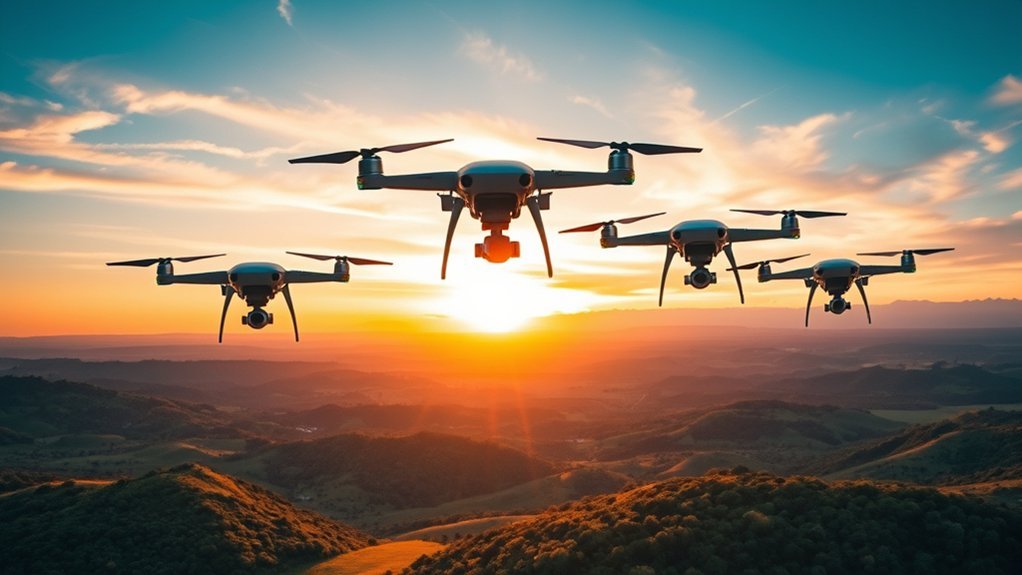For stunning aerial shots in 2025, check out these top drones: Potensic ATOM SE GPS Drone, DJI Mini 4K Drone with 3-axis gimbal, X1 PROMAX 8K Action Drone, Ruko F11GIM2 with GPS, and another DJI Mini 4K variant. They all offer impressive features like 4K to 8K video, long flight times, and stability for clear photos. Each drone suits different needs, so explore further to find your perfect match.
Potensic ATOM SE GPS Drone with 4K Camera (Lightweight and Foldable)
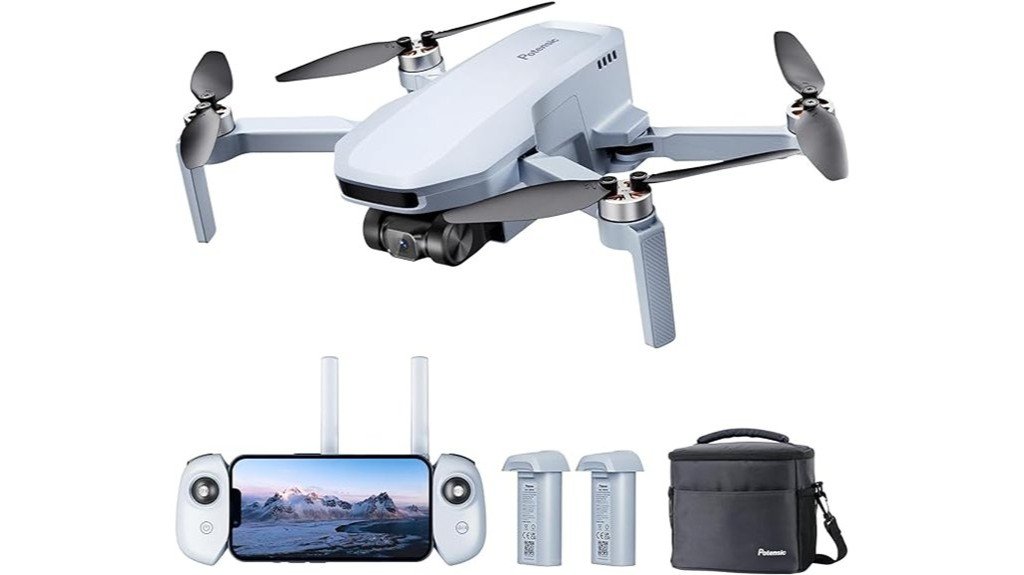
If you’re an adult photographer seeking a lightweight and high-performance drone, the Potensic ATOM SE GPS Drone with a 4K camera might just be your ideal choice. Weighing under 249g, it’s easy to carry and foldable. You’ll enjoy a total flight time of 62 minutes using two batteries, each lasting 31 minutes. The 4K EIS camera, equipped with a 1/3” CMOS Sony Sensor, captures stunning 12MP photos and 4K videos. With a max speed of 16m/s and a 4KM control range, you’re set for thrilling aerial shots. Plus, GPS-enabled auto return guarantees your drone’s safety during signal loss or low power.
Best For: Adult photographers looking for a lightweight, foldable drone with high-performance 4K camera capabilities and reliable GPS features.
Pros:
- Lightweight design under 249g for easy portability.
- High-quality 4K camera with a 1/3” CMOS Sony Sensor for stunning photo and video capture.
- GPS-enabled auto return feature for enhanced safety.
Cons:
- Limited to adult users, not suitable for children.
- Maximum speed and control range may not meet the needs of professional racers.
- Requires compatible iOS or Android device for control.
DJI Mini 4K Drone with UHD Camera and 3-Axis Gimbal Stabilization
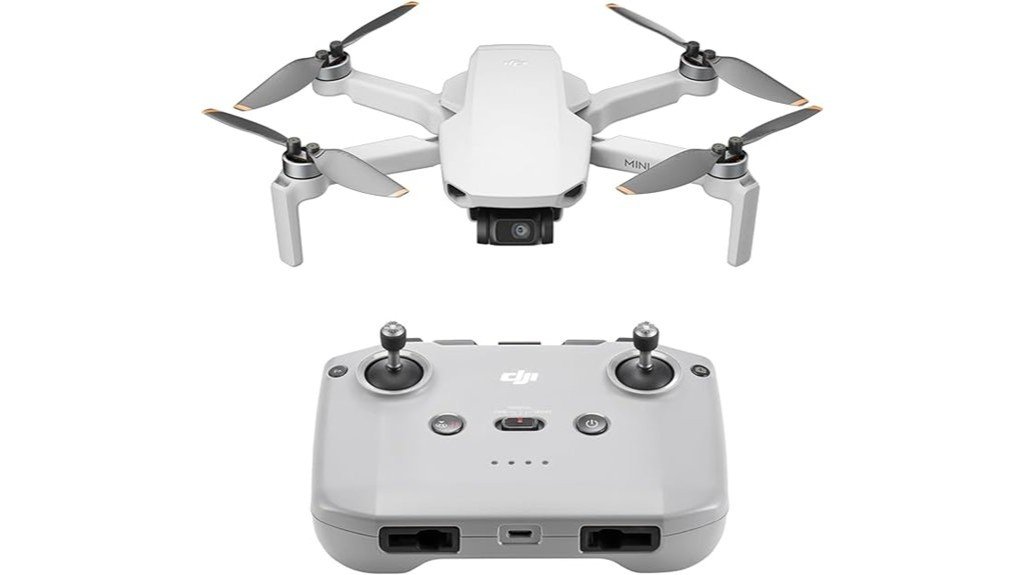
When you’re looking for the perfect drone to elevate your photography, the DJI Mini 4K Drone with UHD Camera and 3-Axis Gimbal Stabilization stands out as an exceptional choice. Weighing under 249 grams, it offers hassle-free operation without FAA registration. Its 4K Ultra HD camera with 12 MP stills guarantees stunning clarity, while the 3-axis gimbal delivers smooth, cinematic shots. Enjoy up to 31 minutes of flight time per battery, with options to extend. User-friendly features like one-tap takeoff and GPS Return to Home make it ideal for beginners. With a 10 km transmission range, capture breathtaking images effortlessly.
Best For: Photography enthusiasts and beginners seeking a lightweight, user-friendly drone with high-quality video capabilities.
Pros:
- No FAA registration required due to its lightweight design.
- Offers a long flight time with options to extend using additional batteries.
- Equipped with a 4K Ultra HD camera and 3-axis gimbal for smooth, cinematic footage.
Cons:
- Limited to a maximum altitude of 4,000 meters.
- May not be suitable for professional use requiring advanced features.
- Wind resistance might not be sufficient for very high wind conditions above 38 kph.
X1 PROMAX 8K Action Flying Camera Drone (Fly Joy Combo)
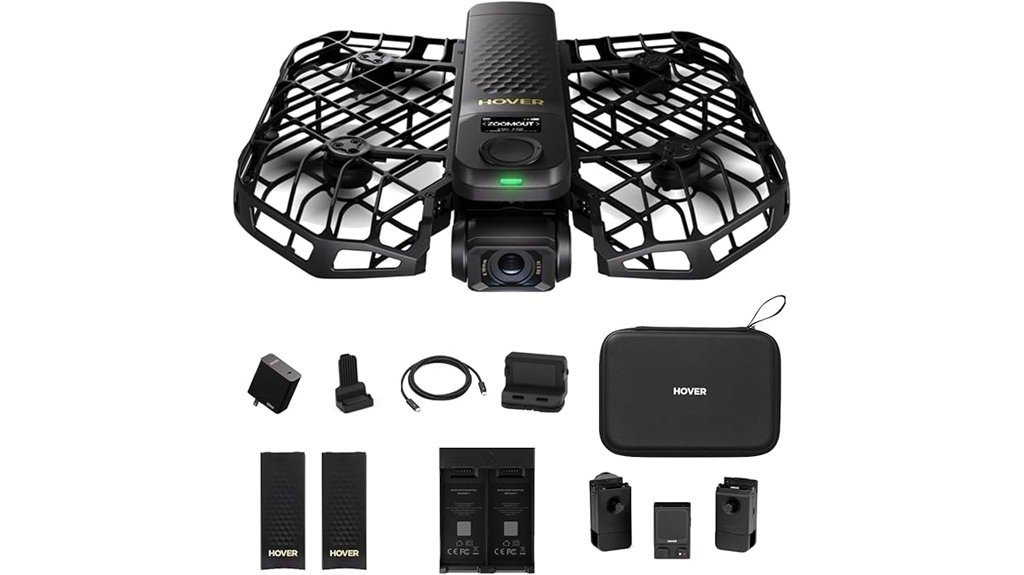
The X1 PROMAX 8K Action Flying Camera Drone (Fly Joy Combo) stands out as an exceptional choice for photography enthusiasts seeking high-resolution aerial footage. With its 8K video at 30fps, you’ll capture sharp, stunning shots. Its lightweight build makes it portable and easy to carry. You can enjoy seamless control with gesture commands and the HOVERAir app. The drone’s OmniTerrain capability guarantees smooth flights over diverse landscapes. However, keep in mind the limited 10-13 minute battery life, and consider carrying spare batteries. While some users note tracking and video stability issues, its impressive features make it a worthy contender.
Best For: Photography enthusiasts looking for high-resolution aerial footage and seamless control through gesture commands.
Pros:
- Captures stunning 8K video at 30fps for high-quality footage.
- Lightweight and portable with a foldable design for easy transportation.
- Offers OmniTerrain capability for smooth flights over various landscapes.
Cons:
- Limited flight time of 10-13 minutes, requiring spare batteries for extended use.
- May struggle with tracking and maintaining stability in complex environments.
- Some users experience issues with video shakiness despite stabilization features.
Ruko F11GIM2 Drone with 4K Camera and GPS
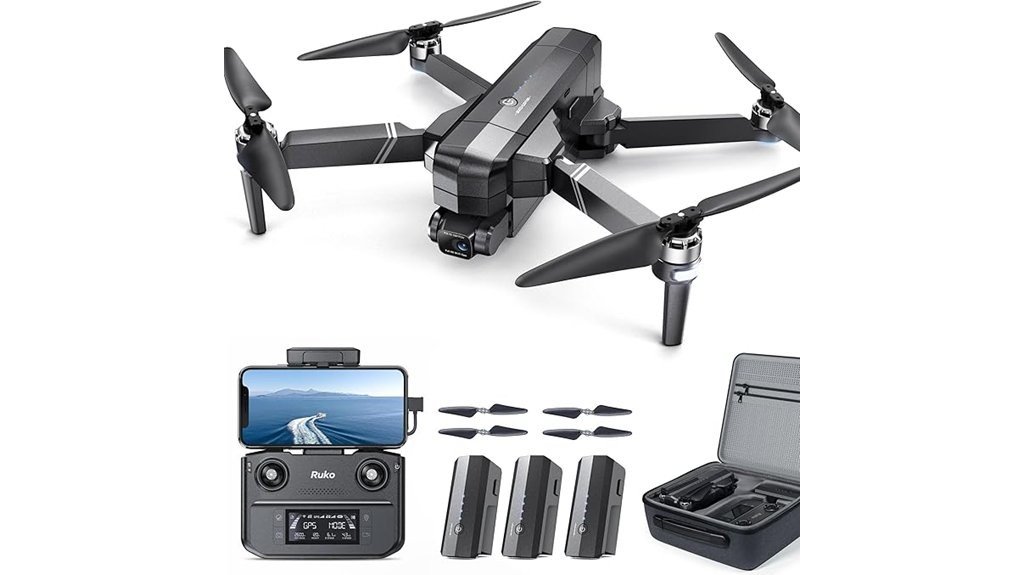
Capturing stunning aerial shots becomes effortless with the Ruko F11GIM2 Drone, making it an excellent choice for photography enthusiasts who crave high-quality visuals and reliable performance. Fly up to 96 minutes using three batteries, and enjoy stable footage thanks to its 2-axis gimbal and EIS technology. The 4K UHD camera captures breathtaking images and videos, while the 5x zoom lets you get closer to the action. With GPS smart return, you won’t worry about losing your drone. Plus, it’s easy to carry in its durable case. You’ll be impressed by its robust wind resistance and impressive altitude capabilities.
Best For: Photography enthusiasts seeking high-quality aerial visuals with reliable performance and user-friendly features.
Pros:
- Long flight time of up to 96 minutes with three batteries.
- 4K UHD camera with 2-axis gimbal and EIS for stabilized shots.
- GPS smart return feature for automatic return on low battery or signal loss.
Cons:
- Requires proprietary Ruko charger to avoid performance issues.
- Limited to flying at a maximum altitude of 6562 ft.
- 5x zoom might not be sufficient for very distant subjects.
DJI Mini 4K Drone with UHD Camera
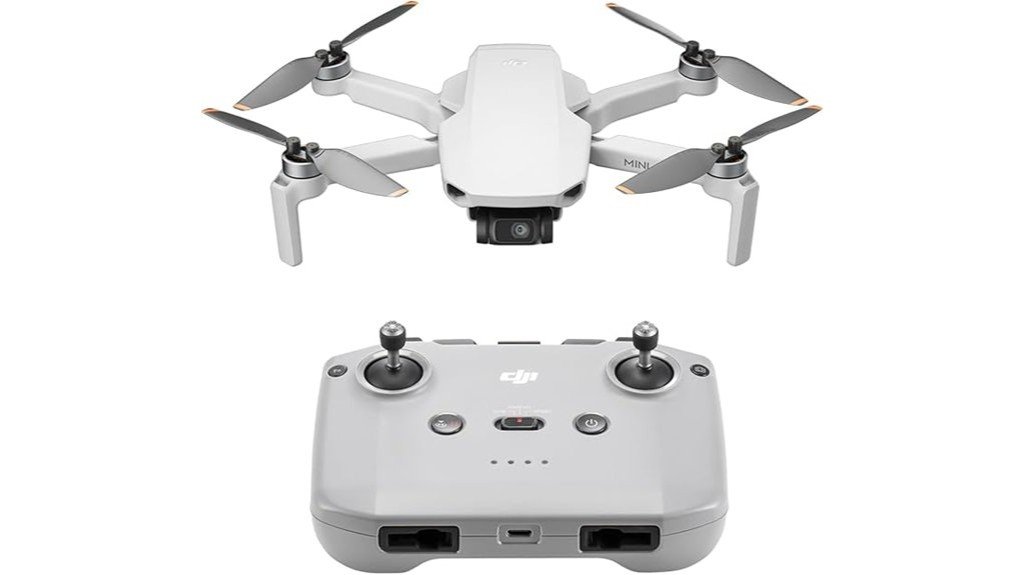
Looking for a lightweight yet powerful aerial companion? The DJI Mini 4K Drone is your perfect choice. Weighing under 249 grams, it offers a 4K Ultra HD camera with 12 MP resolution, letting you capture stunning shots without FAA registration hassle. With a 3-axis gimbal, your videos will have cinematic quality. Enjoy a 10 km transmission range and up to 31 minutes of flight time per battery. It’s beginner-friendly with features like one-tap takeoff, GPS Return to Home, and Intelligent QuickShots. Operating in Level 5 winds, this drone guarantees stable flights, making it a top choice for aerial photography.
Best For: Photography enthusiasts and aerial hobbyists seeking a lightweight, high-quality drone with user-friendly features and no FAA registration hassle.
Pros:
- Weighs under 249 grams, avoiding FAA registration for recreational use.
- Offers cinematic video quality with a 4K Ultra HD camera and 3-axis gimbal stabilization.
- Long transmission range of up to 10 km and extended flight time options with additional batteries.
Cons:
- Limited flight time of up to 31 minutes per battery without purchasing extras.
- May not be suitable for professional use due to its lightweight build and hobbyist classification.
- Requires a micro SD card for media storage, which is not included.
Factors to Consider When Choosing a Drone for Photography
When choosing a drone for photography, you should focus on several key factors. Consider the camera resolution, as it directly impacts the quality of your photos. Don’t forget about flight time, stability, and connectivity, as well as the drone’s portability and weight for easier handling.
Camera Resolution Importance
While choosing a drone for photography, understanding the significance of camera resolution is essential to capturing stunning images. Higher resolutions, measured in megapixels, guarantee sharper and more detailed photos, critical for printing or cropping. Drones with 4K cameras capture video at 3840 x 2160 pixels, offering four times the detail of 1080p HD, perfect for professional work. A common standard like 12MP allows for large prints, up to 16 x 20 inches, without losing quality. The sensor type, such as a 1/3″ CMOS, plays an important role in enhancing image quality, especially in low light, by reducing noise. Pairing high resolution with technologies like Electronic Image Stabilization (EIS) assures smooth, professional-looking shots even in windy conditions.
Flight Time Considerations
Considering the flight time of a drone is essential for photography enthusiasts aiming for uninterrupted shooting sessions. Longer flight times, ranging from 30 to 62 minutes, mean fewer interruptions for battery changes. Check if the drone includes multiple batteries; having three can extend your total flight time up to 96 minutes. Keep in mind, real-world conditions like wind resistance can affect flight duration, with more robust drones offering stable and potentially longer flights. Be aware that aggressive flying or heavy camera loads might reduce flight time by 20-30%. Drones with GPS smart return and auto-landing features provide peace of mind, ensuring safe returns even when battery levels drop, allowing you to focus more on capturing stunning shots.
Stability and Gimbal Features
For photography enthusiasts, stability is key to capturing high-quality aerial images. A drone’s stability is essential, with features like electronic image stabilization (EIS) minimizing vibrations and shake, guaranteeing clearer images and smoother video. Gimbal systems, especially 3-axis stabilization, keep your camera level and steady, even during dynamic movements, for that cinematic touch.
Look for drones with advanced motor systems, such as brushless motors, for consistent, reliable performance even in windy conditions. A wider field of view, up to 118 degrees, enhances your photography, offering expansive shots and better framing. Intelligent flight modes also automate complex techniques, capturing high-quality images with minimal input, boosting stability and composition. These features collectively guarantee your drone photography reaches new heights.
Connectivity and Range
After guaranteeing your drone’s stability and gimbal features, connectivity and range become the next significant considerations for photography. You’ll want robust connectivity options like Bluetooth and Wi-Fi for seamless real-time video transmission and remote control. These features guarantee easy operation and effective monitoring throughout your flight. A drone’s transmission range is vital; some models boast impressive ranges up to 10 km, offering flexibility in capturing distant images. Strong control range helps maintain a stable connection, reducing the risk of losing the drone or experiencing video feed interruptions. Advanced transmission technologies deliver stable video feeds even at longer distances. GPS-enabled drones with smart return-to-home features enhance reliability, automatically guiding the drone back if battery levels drop or signals are lost.
Portability and Weight
Choosing the right drone means balancing portability and weight to suit your photography needs. If you’re a traveler, a compact, foldable drone that fits easily in a backpack is a must. Models under 249 grams are ideal since they typically don’t require FAA registration, adding convenience for recreational use. Lighter drones often offer longer flight times due to less battery strain, but they might struggle with stability in windy conditions. Conversely, heavier drones provide better stability but may have shorter flight durations. Consider how weight affects flight performance—lighter models offer better maneuverability, while heavier ones excel in strong winds. Always check the control range and wind resistance, as weight impacts how well your drone handles various weather conditions.
